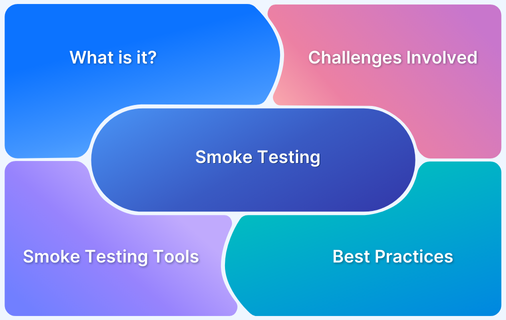What is System Testing? (Examples, Use Cases, Types)
By Sourojit Das, Community Contributor - October 7, 2024
System testing is also known as black-box testing because it focuses on the external parts of the system. It takes place after integration testing and before the acceptance testing. So this testing detects the issues within the integrated units of a system. In this way, it checks the design of the complete system and behavior per the end user’s needs.
- What is System Testing?
- What do you verify in System Testing?
- Scope of System Testing
- System Testing Process
- System Testing Examples and Use Cases
- System Testing Types
- How to write system test cases?
- How to perform System Tests?
- What is System Integration Testing?
- Tools for System Testing
- Challenges in System Testing
- Advantages and Disadvantages of System Testing
- Why run System Tests on Real Devices?
What is System Testing?
System testing is a level of software testing that evaluates the complete and integrated software system to verify that it meets specified requirements.
System testing is performed after integration testing and involves testing the entire application as a whole to ensure that all components work together correctly. It focuses on validating the system’s compliance with functional and non-functional requirements, such as performance, usability, and security.
This type of testing simulates real-world scenarios to identify defects and confirm that the software behaves as expected in a production-like environment, ultimately ensuring the quality and reliability of the system before it is deployed.
What do you verify in System Testing?
You must verify the software requirements, architecture, design, codes, etc., and meet the business requirements and standards. Also, you should verify these software artifacts are error-free and built according to the specifications.
- System testing covers the end-to-end functions of a system, and thus it provides reliability to the system.
- It helps to solve bugs after post-production.
- It tests the entire system architecture as per the business requirement.
- This testing keeps the new and previous functionalities in a single system to help the user understand the benefits of the newly added features.
Scope of System Testing
The scope of system testing includes the following key areas:
- Functional Testing: This ensures that the system meets its requirements and performs the intended functions as specified.
- Non-Functional Testing: This aspect verifies the system’s non-functional requirements, including performance, reliability, usability, and security.
- Interface Testing: This checks that the system properly interfaces with other systems and components, ensuring seamless interaction.
- Stress Testing: This assesses the system’s ability to handle high traffic or load, identifying how it performs under pressure.
- Recovery Testing: This evaluates the system’s capability to recover from failures or errors, ensuring stability and reliability.
While the specific tests conducted during system testing may vary depending on the system, the primary goal is to confirm that the system is ready for end users.
System Testing Process
System testing is a critical phase in the software development lifecycle that ensures the complete application functions as intended before release. It involves validating both functional and non-functional requirements through a structured process that includes planning, design, execution, and closure.
1. Test Planning:
This phase involves defining the scope, objectives, resources, schedule, and testing approach for the system testing process. It sets the groundwork for the entire testing effort.
Example: A team outlines a test plan for an e-commerce application, specifying the types of tests to be performed, such as functional, performance, and security testing, along with timelines and team responsibilities.
2. Test Design:
During this phase, testers create detailed test cases based on the requirements and specifications. Test scenarios are designed to cover all aspects of the system, including edge cases.
Example: For a user login feature, test cases might include scenarios for valid and invalid credentials, password recovery, and account lockout after multiple failed attempts.
In this step, the testing environment is prepared to mirror the production environment as closely as possible. This includes configuring hardware, software, and network settings.
Example: Setting up a staging server that replicates the production database and application configuration to test the new features before going live.
4. Test Execution:
Testers execute the designed test cases in the prepared environment, recording the results and any defects discovered during the process. This phase may involve manual testing or automated scripts.
Example: A tester logs into the e-commerce application, attempts various login scenarios, and documents any errors encountered, such as incorrect error messages or system crashes.
5. Test Closure:
After testing is complete, the team evaluates the results, reports defects, and assesses whether the system meets the acceptance criteria. A final report is created to summarize the testing efforts and outcomes.
Example: The team compiles a report indicating the number of test cases executed, the number passed/failed, and any critical defects that need resolution before deployment, providing a clear overview of the testing process.
System Testing Examples and Use Cases
Here are some of the examples and use cases of System Testing:
- Software Applications: Use cases for an online airline’s booking system – customers browse flight schedules and prices, select dates and times, etc.
- Web Applications: An e-commerce company lets you search and filter items, select an item, add it to the cart, purchase it, and more.
- Mobile Applications: An UPI app let you do mobile recharge or transfer money securely. So, first, you have to select the mobile number, then the biller name, recharge amount, and payment method, and proceed to pay.
- Games: For a gaming app, check the animation, landscape-portrait orientation, background music, sound on/off, score, leaderboard, etc.
- Operating Systems: Login to the system with your password, check your files, folders, apps are well placed and working, battery percentage, time-zone, go to the ‘settings’ for additional checkups, etc.
- Hardware: Test the mechanical parts – speed, temperature, etc., electronic parts – voltage, currents, power input-output, communication parts- bandwidths, etc.
Learn More: Use Case vs Test Case: Core Differences
System Testing Types
System testing encompasses various testing types that ensure both functional and non-functional aspects of an application are thoroughly evaluated.
Functional Testing includes:
- Unit Testing: This initial testing phase checks each individual component or unit of the system to ensure it operates correctly, allowing developers to fix bugs early in the development process.
- Integration Testing: This type validates the interaction between different software units, ensuring they work together seamlessly to achieve the expected functionality.
- Regression Testing: Whenever modifications are made to the software, regression testing verifies that these changes do not introduce new defects or disrupt existing functionality. It is crucial to conduct this testing collaboratively within the development team rather than in isolation.
- User Acceptance Testing (UAT): Conducted by end users, UAT assesses whether the system meets their expectations and requirements, typically performed at the end of the software development lifecycle.
Non-Functional Testing includes:
- Performance Testing: This evaluates how the system performs under various workloads, assessing factors like speed, stability, and responsiveness to ensure it can handle multiple users accessing it simultaneously.
- Security Testing: This involves identifying vulnerabilities within the application, simulating potential attacks to uncover weak points in the code that could be exploited by hackers.
- Usability Testing: Focused on the user experience, usability testing assesses whether the application is intuitive and easy to use, ensuring it includes helpful resources like user manuals or help menus.
- Compatibility Testing: This type checks how well the system functions across different browsers, platforms, operating systems, and devices, ensuring consistent performance regardless of the environment.
How to write system test cases?
Creating effective system test cases is essential for ensuring that a software application meets its requirements and functions correctly. A well-structured test case provides clear guidance on how to test specific functionalities, making it easier to identify defects.
Example Scenario: Testing the login functionality of an e-commerce application.
Step 1. Identify Test Requirements: Review the functional requirements for the login feature, such as acceptable usernames, passwords, and login error messages.
Step 2. Define Test Case Title: Create a clear and descriptive title for the test case.
Example: “Verify successful login with valid credentials.”
Step 3. Specify Preconditions: List any prerequisites that must be met before executing the test case.
Example: User must have a registered account with valid credentials.
Step 4. Outline Test Steps: Provide a step-by-step guide on how to execute the test case.
Example:
- Open the e-commerce application login page.
- Enter the valid username in the username field.
- Enter the valid password in the password field.
- Click the “Login” button.
Step 5. Define Expected Results: Clearly state what the expected outcome is after executing the test steps.
Example: User is successfully logged in and redirected to the homepage.
Step 6. Specify Postconditions: Indicate the state of the application after the test case has been executed.
Example: User session is active, and user profile details are accessible.
Step 7. Document Additional Information: Include any relevant details, such as test case ID, priority, and any dependencies.
Example:
- Test Case ID: TC001
- Priority: High
- Dependencies: User registration must be completed.
How to perform System Tests?
Here are the steps to perform System Tests:
- First, you need to make a test plan with the entry and exit criteria of the testing.
- Then, create the test scenarios and test cases. Follow an appropriate template for this purpose.
- After the test case generation, gather the required test data for proper test execution.
- Set up the test environment. It’s essential to execute the test cases in the production environment.
- Execute the test cases and record the results (passed or failed).
- Create the defect report and send it to the development team.
- After they send the rectified software, you have to test the previously affected parts of the software again and repeat the cycle as per the requirement.
What is System Integration Testing?
The SIT combines multiple integrated components. The components include different software, hardware, or both software and hardware. It’s a type of black-box testing that indicates software functioning well with the concurrence of another system.
Tools for System Testing
Here is the list of tools used for System Testing:
1. Selenium
Selenium is an open-source tool for automating web browsers. It supports various programming languages and can simulate user interactions.
Advantages:
- Highly customizable and supports multiple browsers.
- Strong community support and extensive documentation.
Limitations:
- Requires programming knowledge for effective use.
- Limited support for non-web applications.
2. Apache JMeter
It is a powerful open-source tool for performance and load testing of web applications.
Advantages:
- Supports a wide range of protocols (HTTP, FTP, etc.).
- Provides comprehensive reporting and analysis features.
Limitations:
- User interface can be complex for beginners.
- Requires configuration for advanced testing scenarios.
3. TestComplete
TestComplete is a commercial tool for automated UI testing of desktop, web, and mobile applications.
Advantages:
- User-friendly interface with record-and-playback capabilities.
- Supports a variety of scripting languages and technologies.
Limitations:
- Costly compared to open-source alternatives.
- May have a steep learning curve for complex scenarios.
4. Postman
Postman is a widely used tool for API testing that allows developers to create and execute HTTP requests.
Advantages:
- Intuitive interface for creating and testing API requests.
- Supports automation through collections and environments.
Limitations:
- Primarily focused on API testing, not suitable for UI testing.
- Limited reporting features compared to dedicated testing tools.
5. LoadRunner
LoadRunner is a commercial performance testing tool that simulates virtual users to test application performance under load.
Advantages:
- Comprehensive analysis and reporting capabilities.
- Supports a wide range of applications and protocols.
Limitations:
- High licensing costs, making it less accessible for small teams.
- Requires specialized training to use effectively.
These tools provide various features and capabilities, catering to different testing needs and environments, from web applications to APIs and performance testing.
One of the standout features of BrowserStack’s Test Management tool is its seamless integration with popular CI/CD tools like Jenkins, Travis CI, and CircleCI. To maximize efficiency in your system testing process, incorporate automated test execution into your CI/CD workflow. This allows you to run tests across a wide range of real devices and browsers every time you push code changes.
By automating your testing in this way, you can catch bugs earlier in the development cycle, reduce the time spent on manual testing, and ensure consistent performance and compatibility of your application across different environments. Plus, with detailed reporting and analytics provided by BrowserStack, you can easily track test results and make data-driven decisions for your development process.
Challenges in System Testing
Here are the core challenges faced in System Testing:
- Time and Resource Constraints: These are the significant challenges in system testing. The QA team goes under pressure due to last-minute testing requirements. Additionally, an unstable environment can cause huge time delays. So, choosing the proper environment setup, testing tools, and communication helps to solve the problem.
- The Complexity of Applications: To test complex applications, you must perform regression testing several times. So, it becomes time-consuming and creates pressure to finish the task on a tight deadline. Thus, proper planning, prioritizing the test case, and up-skilling the test team can solve the issue.
- Lack of Test Coverage: The QA team can’t cover all the tests due to a lack of time, documentation, and inadequate testing. So, it would be best if you had a proper plan and prioritize the test cases according to the need. Also, you have to cover the test cases by performing both automation and manual testing.
- Defect Management: Nowadays, most systems have become large and multilayered in codes. Thus there is a huge chance of missing any defect or bug, and they bother user experience, damage the system, and more. So you need to test with real devices, defect management tools, and automated testing tools to find, report, track, and solve the defects effectively.
Advantages and Disadvantages of System Testing
Understanding the advantages and disadvantages of System Testing for efficient testing.
Advantages of System Testing
Here are some of the advantages of System Testing:
- Comprehensive Validation:
System testing evaluates the entire application as a whole, ensuring that all components work together as intended. - Early Bug Detection:
Identifying defects before deployment helps reduce the cost and time associated with fixing issues after release. - Improved Quality Assurance:
System testing enhances the overall quality of the software, leading to higher user satisfaction and fewer post-launch issues. - Verification of Non-Functional Requirements:
It assesses performance, security, usability, and other non-functional aspects, ensuring the application meets user expectations. - User Acceptance Preparation:
By mimicking real-world scenarios, system testing prepares the software for user acceptance testing (UAT), aligning it with user needs.
Disadvantages of System Testing
Here are some of the disadvantages of System Testing:
- Time-Consuming:
The comprehensive nature of system testing can make it time-intensive, potentially delaying the overall development timeline. - Resource Intensive:
It requires significant resources, including skilled testers, testing environments, and tools, which can increase project costs. - Complex Test Case Design:
Creating effective test cases for all functionalities can be complex and may require detailed knowledge of the system architecture. - Limited Scope for Continuous Changes:
Frequent changes in requirements may necessitate repeated cycles of testing, which can be challenging to manage. - Risk of Incomplete Coverage:
Due to the vast number of functionalities, there’s a risk that some scenarios or edge cases may be overlooked, leading to undetected issues.
Why run System Tests on Real Devices?
Running system tests on real devices using BrowserStack Automate is crucial for achieving accurate and reliable results.
Unlike emulators or simulators, real devices provide a true representation of user experiences, enabling testers to identify device-specific issues such as screen resolution discrepancies, performance variances, and touch responsiveness.
BrowserStack’s extensive range of real devices ensures comprehensive coverage across different operating systems, browsers, and hardware configurations. This allows teams to simulate real-world conditions, enhancing the quality of their applications and ensuring they perform seamlessly for end users, regardless of the device they choose.
Conclusion
In summary, system testing plays a crucial role in the software development process by ensuring that an application works effectively as a whole. This phase not only checks that the software meets its functional requirements but also evaluates aspects like performance, security, and user experience.
By identifying defects before the software reaches end users, system testing helps enhance overall quality and satisfaction. With a mix of different testing approaches, such as functional, non-functional, and user acceptance testing, organizations can be confident that their applications will perform well in real-world conditions.
Ultimately, thorough system testing is key to delivering a reliable and high-quality product.




